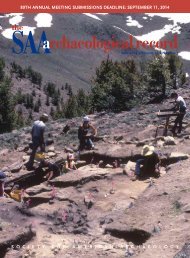SAA
Nov2016_web
Nov2016_web
You also want an ePaper? Increase the reach of your titles
YUMPU automatically turns print PDFs into web optimized ePapers that Google loves.
VIDEO GAMES AND ARCHAEOLOGY<br />
Heritage work in Rosewood has already benefited from a similar<br />
approach. Numerous write-ups in newspapers and magazines<br />
across Florida continue to generate public interest in the<br />
project and provide access to new, privately owned areas of the<br />
town (González-Tennant 2013:85–86). A similar project is<br />
nearing completion in regard to the Maroon experience in<br />
Florida, and particularly as it relates to the sites of Prospect<br />
Bluff and Angola (Baram 2012). Prospect Bluff, also known as<br />
Fort Gadsden or the Negro Fort, was a repurposed fort occupied<br />
by a Maroon community destroyed when forces under<br />
Andrew Jackson’s command successfully fired upon the fort’s<br />
powder magazine. The resulting explosion obliterated the fort<br />
and killed 270 of its inhabitants, a mix of emancipated African<br />
slaves and members of local indigenous tribes.<br />
Figure 5. Updated version of the Rosewood virtual world.<br />
virtual world incorporates this aspect of walking simulators<br />
(Figure 5). A series of oral histories with survivors and their<br />
descendants—collected through my and earlier research—<br />
provide an emotionally powerful method for users to better<br />
understand the lives of those affected. This technique also<br />
allows visitors to investigate the timeline of the riot, which<br />
extended over a period of seven days. Although there is no<br />
linear narrative in the planned updates to the Rosewood virtual<br />
world, it is possible to piece together the series of events<br />
that destroyed the town by exploring the virtual world. This<br />
interactive aspect represents the single largest update to the<br />
virtual world. The current version of the Rosewood virtual<br />
world provides users with an immersive experience. The<br />
update, guided by walking simulators, makes full use of the<br />
interactive potentials of video games to support an ongoing<br />
public outreach program.<br />
The virtual reconstruction of Prospect Bluff (Figure 6) allows<br />
users to experience this site as it existed for the first time in<br />
200 years. The simple act of looking through the fort’s windows<br />
or over its walls along the Apalachicola River offers a<br />
unique opportunity to experience a past landscape that no<br />
longer exists. A virtual world is the only method for retrieving<br />
the experiential nature of life at the site, short of physically<br />
reconstructing buildings, which is unlikely given the<br />
site’s remote location. Techniques from walking simulators<br />
and the Rosewood virtual world are also being adopted for<br />
this project. The landscape is reconstructed from freely available<br />
LiDAR data, and visitors’ exploration of the site is accentuated<br />
through the use of on-site audio recordings and<br />
original 3D models accurately representing structures, tools,<br />
and crops dating to the period. The ability to experience common<br />
aspects of everyday life at this destroyed community is<br />
at the center of a series of public outreach events across the<br />
state. These events and the virtual world are designed to<br />
raise public awareness of the state’s unique Maroon heritage.<br />
Walking Simulators as Applied Archaeology<br />
The rise of walking simulators points to powerful new potentials<br />
for applied archaeology. This growth demonstrates that<br />
projects connecting players to sensitive treatments of mature<br />
topics is not only commercially viable but also speaks to a<br />
growing demographic who yearn for something different<br />
than the linear stories common to video games. I hesitate to<br />
refer to this as some kind of growing maturity among those<br />
who play video games. Instead, I think the appearance of<br />
these games addresses a long-held interest that major game<br />
studios have neglected for too long. Walking simulators<br />
address this interest by crafting experiences that provide<br />
players with the opportunity to deeply connect to the experiences<br />
of others.<br />
Figure 6. Preliminary view of the Prospect Bluff virtual world.<br />
November 2016 • The <strong>SAA</strong> Archaeological Record<br />
27




